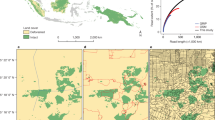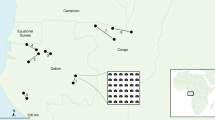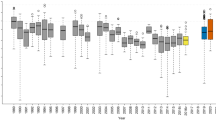Abstract
Many countries have adopted large-scale tree planting programmes as a climate mitigation strategy and to support local livelihoods. We evaluate a series of large-scale tree planting programmes using data collected from historical Landsat imagery in the state of Himachal Pradesh in Northern India. Using this panel dataset, we use an event study design to estimate the socioeconomic and biophysical impacts over decades of these programmes. We find that tree plantings have not, on average, increased the proportion of forest canopy cover and have modestly shifted forest composition away from the broadleaf varieties valued by local people. Further cross-sectional analysis, from a household livelihood survey, shows that tree planting supports little direct use by local people. We conclude that decades of expensive tree planting programmes in this region have not proved effective. This result suggests that large-scale tree planting may sometimes fail to achieve its climate mitigation and livelihood goals.
This is a preview of subscription content, access via your institution
Access options
Access Nature and 54 other Nature Portfolio journals
Get Nature+, our best-value online-access subscription
$29.99 / 30 days
cancel any time
Subscribe to this journal
Receive 12 digital issues and online access to articles
$119.00 per year
only $9.92 per issue
Buy this article
- Purchase on Springer Link
- Instant access to full article PDF
Prices may be subject to local taxes which are calculated during checkout




Similar content being viewed by others
Data availability
Replication data and materials for this analysis are available in the Data Repository for University of Minnesota: https://doi.org/10.13020/j6sj-jw18.
Code availability
Replication code for statistical analysis is also available in the Data Repository for University of Minnesota: https://doi.org/10.13020/j6sj-jw18.
References
Seymour, F. Seeing the forests as well as the (trillion) trees in corporate climate strategies. One Earth 2, 390–393 (2020).
Lewis, S. L., Wheeler, C. E., Mitchard, E. T. A. & Koch, A. Restoring natural forests is the best way to remove atmospheric carbon. Nature 568, 25–28 (2019).
Hawes, M. Planting carbon storage. Nat. Clim. Change 8, 556–558 (2018).
Payn, T. et al. Changes in planted forests and future global implications. Ecol. Manag. 352, 57–67 (2015).
Fleischman, F. et al. Pitfalls of tree planting show why we need people-centered natural climate solutions. Bioscience 70, 947–950 (2020).
Brancalion, P. H. S. & Holl, K. D. Guidance for successful tree planting initiatives. J. Appl. Ecol. 57, 2349–2361 (2020).
Temperton, V. M. et al. Step back from the forest and step up to the Bonn Challenge: How a broad ecological perspective can promote successful landscape restoration. Restor. Ecol. 27, 705–719 (2019).
Fagan, M. E., Reid, J. L., Holland, M. B., Drew, J. G. & Zahawi, R. A. How feasible are global forest restoration commitments? Conserv. Lett. 13, e12700 (2020).
Heilmayr, R., Echeverría, C. & Lambin, E. F. Impacts of Chilean forest subsidies on forest cover, carbon and biodiversity. Nat. Sustain. 3, 701–709 (2020).
India’s Intended Nationally Determined Contribution: Working Towards Climate Justice (Government of India, 2015).
Zeng, Y. et al. Economic and social constraints on reforestation for climate mitigation in Southeast Asia. Nat. Clim. Change 10, 842–844 (2020).
Le, H. D., Smith, C., Herbohn, J. & Harrison, S. More than just trees: assessing reforestation success in tropical developing countries. J. Rural Stud. 28, 5–19 (2012).
Adams, C., Rodrigues, S. T., Calmon, M. & Kumar, C. Impacts of large-scale forest restoration on socioeconomic status and local livelihoods: What we know and do not know. Biotropica 48, 731–744 (2016).
Malkamäki, A. et al. A systematic review of the socio-economic impacts of large-scale tree plantations, worldwide. Glob. Environ. Change 53, 90–103 (2018).
Holl, K. D. & Brancalion, P. H. S. Tree planting is not a simple solution. Science 368, 580–581 (2020).
Davis, D. K. & Robbins, P. Ecologies of the colonial present: Pathological forestry from the taux de boisement to civilized plantations. Environ. Plan. E Nat. Space 1, 447–469 (2018).
Fleischman, F. D. Why do foresters plant trees? Testing theories of bureaucratic decision-making in central India. World Dev. 62, 62–74 (2014).
Dubash, N. K., Khosla, R., Kelkar, U. & Lele, S. India and Climate Change: Evolving ideas and increasing policy engagement. Annu. Rev. Environ. Resour. 43, 395–424 (2018).
Nath, A. J. et al. Quantifying carbon stocks and sequestration potential in agroforestry systems under divergent management scenarios relevant to India’s Nationally Determined Contribution. J. Clean. Prod. 281, 124831 (2021).
Gundimeda, H. & Shyamsundar, P. Forests, sustainability and poverty in India. Environ. Dev. Econ. 17, 373–378 (2012).
Saxena, N. C. India’s Eucalyptus Craze: The God that Failed (SAGE Publications, 1994).
Asher, M. & Bhandari, P. Mitigation or myth? Impacts of hydropower development and compensatory afforestation on forest ecosystems in the high Himalayas. Land Use Policy 100, 105041 (2021).
Valencia, L. M. Compensatory Afforestation in Odisha, India: A Political Ecology of Forest Restoration (Univ. of Toronto, 2019).
Davidar, P. et al. Assessing the extent and causes of forest degradation in India: Where do we stand? Biol. Conserv. 143, 2937–2944 (2010).
Puyravaud, J. P., Davidar, P. & Laurance, W. F. Cryptic destruction of India’s native forests. Conserv. Lett. 3, 390–394 (2010).
Ramprasad, V., Joglekar, A. & Fleischman, F. Plantations and pastoralists: Afforestation activities make pastoralists in the Indian Himalaya vulnerable. Ecol. Soc. 25, 1 (2020).
Report of the National Commission on Agriculture, Part IX: Forestry (Ministry of Agriculture and Irrigation, Government of India, 1976).
Agarwal, B. Cold Hearths and Barren Slopes: The Wood Fuel Crisis in the Third World (Allied Publishers, 1986).
Blaikie, P. M. & Muldavin, J. S. S. Upstream, downstream, China, India: the politics of environment in the Himalayan Region. Ann. Assoc. Am. Geogr. 94, 520–548 (2004).
Saberwal, V. K. Pastoral Politics: Shepherds, Bureaucrats, and Conservation in the Western Himalaya (Oxford Univ. Press, 1999).
Vasan, S. Living with Diversity: Forestry Institutions in Western Himalaya (Indian Institute of Advanced Study, 2006).
Gouri, S. M., Morrison, E. & Mayers, J. Policy Influences on Forest-based Livelihoods in Himachal Pradesh, India (International Institute for Environment and Development, 2004).
Rana, P. & Miller, D. C. Machine learning to analyze the social-ecological impacts of natural resource policy: Insights from community forest management in the Indian Himalaya. Environ. Res. Lett. 14, 24008 (2019).
Cunningham, S. Causal Inference: The Mixtape (Yale Univ. Press, 2018).
Gallagher, J. Learning about an infrequent event: evidence from flood insurance take-up in the United States. Am. Econ. J. Appl. Econ. 6, 206–233 (2014).
West, S. G. et al. Alternatives to the randomized controlled trial. Am. J. Public Health 98, 1359–1366 (2008).
Baland, J. M., Bardhan, P., Das, S. & Mookherjee, D. Forests to the people: Decentralization and forest degradation in the Indian Himalayas. World Dev. 38, 1642–1656 (2010).
Aggarwal, A. Improving forest governance or messing it up? Analyzing impact of forest carbon projects on existing governance mechanisms with evidence from India. Policy Econ. 111, 102080 (2020).
Shahabuddin, G. & Thadani, R. in Conservation and Development in India: Reimagining Wilderness (ed. Bhagwat, S.) 109–131 (Routledge, 2018).
Duguma, L. et al. From Tree Planting to Tree Growing: Rethinking Ecosystem Restoration Through Trees Working Paper 304 (World Agroforestry, 2020); https://doi.org/10.5716/WP20001.pdf
Robbins, P. The practical politics of knowing: State environmental knowledge and local political economy. Econ. Geogr. 76, 126–144 (2000).
Andersson, K., Lawrence, D., Zavaleta, J. & Guariguata, M. R. More trees, more poverty? The socioeconomic effects of tree plantations in Chile, 2001–2011. Environ. Manag. 57, 123–136 (2016).
India State of Forest Report 2019 Vol. I (Forest Survey of India, 2019); https://fsi.nic.in/forest-report-2019?pgID=forest-report-2019
Callaway, B. & Sant’Anna, P. H. C. Difference-in-differences with multiple time periods. J. Econom. https://doi.org/10.1016/j.jeconom.2020.12.001 (2020).
Busch, J. et al. Potential for low-cost carbon dioxide removal through tropical reforestation. Nat. Clim. Change 9, 463–466 (2019).
Di Sacco, A. et al. Ten golden rules for reforestation to optimize carbon sequestration, biodiversity recovery and livelihood benefits. Glob. Change Biol. 27, 1328–1348 (2021).
Höhl, M. et al. Forest landscape restoration: what generates failure and success? Forests 11, 938 (2020).
Crouzeilles, R. et al. A global meta-analysis on the ecological drivers of forest restoration success. Nat. Commun. 7, 11666 (2016).
Adler-Golden, S. et al. FLAASH, a MODTRAN4 atmospheric correction package for hyperspectral data retrievals and simulations. Proc. 7th Ann. JPL Airborne Earth Sci. Work. 1, 9–14 (1998).
Makantasis, K., Karantzalos, K., Doulamis, A. & Doulamis, N. in International Geoscience and Remote Sensing Symposium (IGARSS) 4959–4962 (IEEE, 2015); https://doi.org/10.1109/IGARSS.2015.7326945
Congalton, R. G. A review of assessing the accuracy of classifications of remotely sensed data. Remote Sens. Environ. 37, 36–46 (1991).
Jensen, J. R. Introductory Digital Image Processing: A Remote Sensing Perspective (Pearson Education, 2016).
Allison, P. D. & Waterman, R. P. Fixed-effects negative binomial regression models. Sociol. Methodol. 32, 247–265 (2002).
Acknowledgements
We thank our field researchers for data collection. B. Lawrence assisted with geospatial processing tasks. Research was funded by NASA Land Cover and Land Use Change (LULUC): NNX17AK14G, which supported the work of all authors.
Author information
Authors and Affiliations
Contributions
F.F., E.C., V.R., H.F. and P.R. conceived the study, and F.F. oversaw data collection. V.R. led survey data collection and V.G. and R.R. contributed. A.F. and B.G. oversaw geospatial processing, with A.M. contributing. E.C. and B.S. designed and conducted the data analysis, with feedback from other authors. E.C. led revision of the final manuscript, and B.S., V.R., H.F., P.R., A.F., B.G., C.R.S. and F.F. contributed to writing the manuscript and Supplementary Information.
Corresponding author
Ethics declarations
Competing interests
The authors declare no competing interests.
Additional information
Peer review information Nature Sustainability thanks the anonymous reviewers for their contribution to the peer review of this work.
Publisher’s note Springer Nature remains neutral with regard to jurisdictional claims in published maps and institutional affiliations.
Supplementary information
Supplementary Information
Supplementary Tables 1–15 (Landsat image classification accuracies), 16–23 (additional statistical tests and summary statistics) and 24–27 (robustness checks for household data using livelihood support and forest dependence) and Figs. 1–4 (summary data) and 5–8 (impacts for more forest cover outcomes).
Rights and permissions
About this article
Cite this article
Coleman, E.A., Schultz, B., Ramprasad, V. et al. Limited effects of tree planting on forest canopy cover and rural livelihoods in Northern India. Nat Sustain 4, 997–1004 (2021). https://doi.org/10.1038/s41893-021-00761-z
Received:
Accepted:
Published:
Issue Date:
DOI: https://doi.org/10.1038/s41893-021-00761-z
This article is cited by
-
Escaping chronic poverty: long-term impacts of an agricultural development program
Environment, Development and Sustainability (2024)
-
Working for the environment: farmer attitudes towards sustainable farming actions in rural Wales, UK
Environment, Development and Sustainability (2024)
-
Combining socioeconomic and biophysical data to identify people-centric restoration opportunities
npj Biodiversity (2023)
-
Resolving land tenure security is essential to deliver forest restoration
Communications Earth & Environment (2023)
-
Forest regrowth improves people’s dietary quality in Nigeria
npj Sustainable Agriculture (2023)



